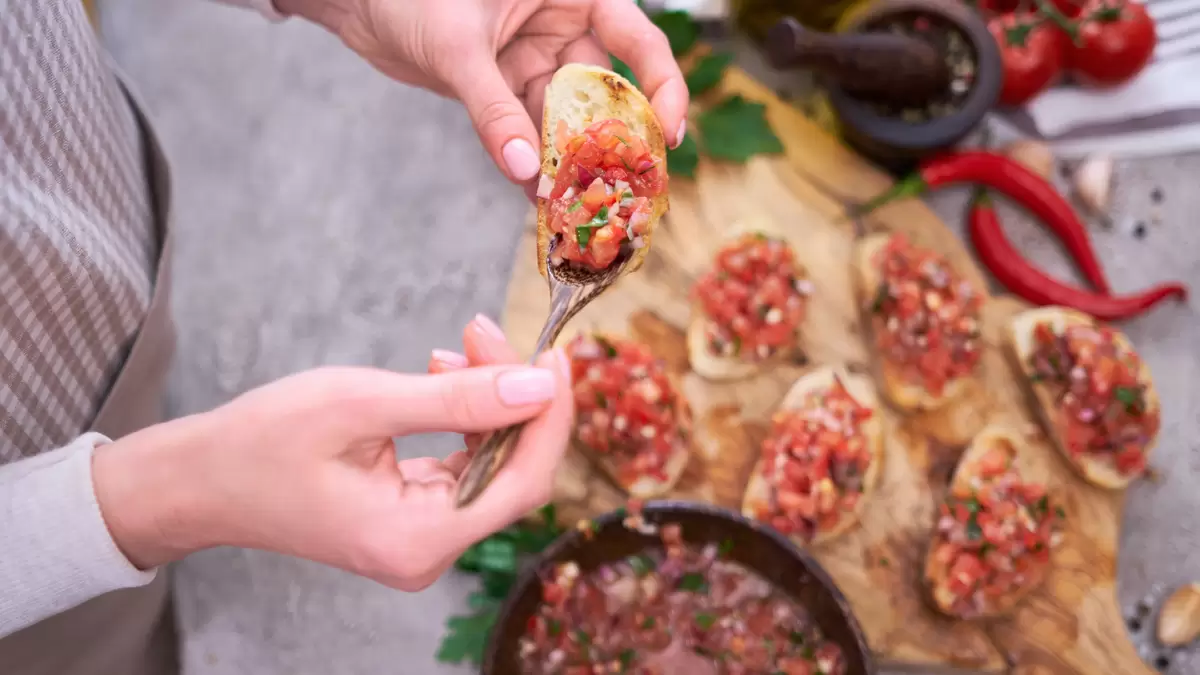Join Our Newsletter
Get our best recipes and health tips delivered right to your inbox!

If you love fresh, flavorful toppings for bread, chips, veggie sticks, or main dishes, you’ve probably enjoyed both bruschetta and salsa. They’re both typically packed with tomatoes, herbs, and bright flavors. But if you’re wondering which is healthier, bruschetta or salsa, the answer depends on a few factors, such as how they’re made and what you serve them with.
Here’s some insight into how healthy bruschetta and salsa are, whether one has an advantage over the other, and how you can make both even better for you.
At first glance, bruschetta and salsa might seem very similar. They both usually use tomatoes as their primary ingredient, although there are many variations of each that include different ingredients. As similar as they may seem, they come from varied culinary traditions and are made a little differently.
Bruschetta is an Italian appetizer that usually starts with toasted bread topped with a mixture of diced tomatoes, olive oil, garlic, basil, and sometimes balsamic vinegar. While the bread is the traditional base, the tomato topping is fresh and flavorful on its own.
Salsa is a staple in Mexican cuisine, and when it’s made with fresh ingredients, it may be referred to as pico de gallo. Fresh salsa typically includes tomatoes, onions, cilantro, lime juice, and peppers for heat. It’s usually served with tortilla chips but also makes a flavorful topping for tacos, grilled meats, or vegetables.
The main difference between these two tomato-based mixtures is that bruschetta is typically served on bread, while salsa is usually served as a dip. That difference in serving style can make a big difference in calories and carbs. But eating bruschetta and salsa with bread or chips is not the only way to enjoy them, and skipping these high-calorie accompaniments can make them healthier.
Bruschetta’s tomato topping is full of vitamins like vitamin C and lycopene, an antioxidant linked to heart health. Olive oil adds healthy fats, and garlic and basil impart flavor without added sugar or salt.
The bread is where calories and carbs add up, especially if it’s white bread brushed with oil. Using whole-grain bread or serving the tomato mixture over cucumber slices or whole-wheat crackers can make bruschetta a lighter, more nutrient-dense option. It also makes a delicious topping for lean protein, such as in this Bruschetta Chicken.
Fresh salsa is naturally low in calories and fat while being big on flavor. Typical salsa ingredients like tomatoes, onions, and peppers have antioxidants, vitamin C, and fiber. Lime juice and fresh herbs like cilantro add brightness without sodium. There are many ways to make salsa, including adding a variety of plant-based ingredients, such as corn, beans, mango, and watermelon, among others, and each offers vitamins, minerals, and nutrients.
The biggest health concern with salsa isn’t the salsa itself. It’s what you eat it with. Piling it onto greasy tortilla chips adds saturated fat, sodium, and calories. For a healthier pairing, try baked tortilla chips, whole-grain pita crisps, or veggie sticks. Or use salsa as a topping for grilled chicken or fish, like in this Grilled Chicken with Corn Salsa.
There are endless ways to make flavorful and healthy bruschetta and salsa. Here are some of our most popular recipes. As you’ll see, they can get a bit creative when it comes to ingredients used, but all are delicious, nutritious, and easy to make.
Mini multigrain baguette toasts are topped with three flavorful options—tomato‑basil, Kalamata olive‑red pepper‑feta, and pistachio‑cilantro—to deliver a tangy, veggie‑packed rendition of classic Italian bruschetta.
This simple and juicy bruschetta features red and yellow cherry tomatoes, garlic, red onion, basil, and balsamic vinegar. It’s served on whole‑grain baguette slices for a fresh, heart‑healthy appetizer.
Crusty toasted bread is adorned with a bright lemony crab mixture that includes lump crabmeat, olive oil, lemon juice, capers, shallots, and parsley for a flavorful and unique starter.
This vibrant salsa blends corn and black beans with cilantro, scallions, tomatoes, chili powder, and lime juice, resulting in a flavorful, heart‑friendly dip. Chill for at least an hour and serve with whole‑grain tortilla chips or veggie sticks.
A crowd‑pleasing fruit salsa combining fresh mango, a fiery mix of serrano, jalapeño, and habanero peppers, garlic, citrus, and cilantro, this salsa is bright, sweet, and spicy in one low‑calorie but vibrantly-flavored dish.
This low‑sodium, low‑fat green sauce blends fresh herbs, jalapeño, shallots, capers, anchovies, and olive oil into a vibrant salsa that takes just 10 minutes to make and pairs well with grilled meats or fish.
If we’re just looking at bruschetta and salsa on their own, without any accompaniments such as bread or chips, both are healthy choices made with fresh vegetables and herbs. Salsa tends to be lower in calories because it doesn’t usually contain oil. The olive oil in bruschetta is heart-healthy but it does make bruschetta more calorie-dense.
Calories in bruschetta and salsa can vary depending on the ingredients they include. A basic fresh tomato bruschetta topping without bread is usually around 30–50 calories per ¼ cup, but when served on a slice of toasted bread with olive oil, it can easily climb to 100–150 calories or more per piece. Fresh tomato salsa has fewer calories—often just 15–25 calories per ¼ cup—since it typically contains no added oil. Eating it with tortilla chips can make calorie counts escalate quickly.
Bruschetta and salsa can both be part of a healthy diet if you enjoy them with nutrient-rich bases or use them as a topping for lean proteins. When you’re eating them with chips or toasted bread, just be sure to watch portion sizes if you’re concerned with how healthy they are and how many calories they contain.